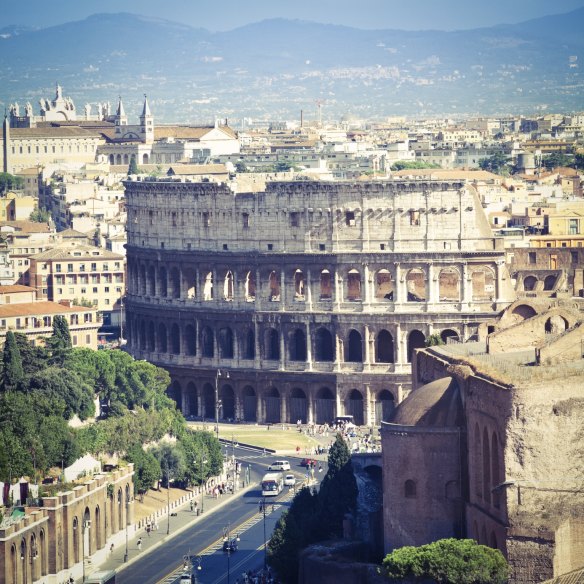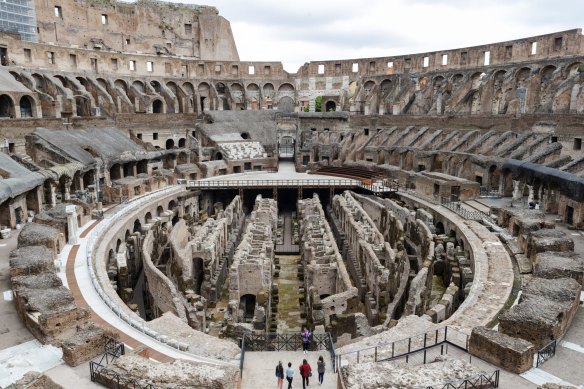A not-so-brief history of the Colosseum for confused tourists (and vandals)
By Andrea Salcedo
Long before modern-day tourists carved their initials and love notes on the walls of the Colosseum, spectators of what was once the largest amphitheatre of the Roman Empire also etched their names on the monument’s surfaces.
The graffiti of 1st-century Roman visitors has been found during restorations of the Colosseum, but they were hardly the last defacers of this ancient marvel. Among the later vandals was French Romanticist painter Hubert Robert, who sometime in 1767 carved his name into the walls of the amphitheatre’s ruins while completing a residence at the French Academy in Rome.

The Colosseum was “like Broadway”.Credit: iStock
Robert’s signature did not draw the ire of Italians like the man recently captured on video carving the name of his girlfriend on the almost 2,000-year-old structure. In a letter addressed to city officials, Ivan Danailov Dimitrov, 27, apologised for vandalising the UNESCO World Heritage Site and acting with “frivolousness, flippancy and incivility, to the detriment of other visitors.”
“I have no excuses,” he wrote in Italian in the letter, which was translated by The Washington Post.
The Colosseum, which was financed by three emperors from the Flavian dynasty, opened its doors in 80 AD. It could seat up to 50,000 spectators gathered to watch gladiators fighting for glory, humans hunting exotic animals like panthers and plays reenacting historical battles. The massive arena had three tiers of elevated seats granting everyone a clear view of the spectacles.
“This was like Broadway,” Jorge Otero-Pailos, a professor and director of historic preservation at Columbia University, told The Post.
The Roman emperor was the main organiser of the spectacles, which were designed to entertain the crowds, but perhaps most importantly, keep them placated, so they would not rebel against the ruler.
The Colosseum also served to buttress the emperor’s political machinations. The names of senior senators were carved into stones marking their reserved seats on the first level. The second and third levels were designated for knights and Roman citizens, respectively. Noncitizens sat at the top, reflecting the strict social hierarchy of the empire. At the centre of the arena was the emperor, seated prominently, so everyone could see him and cheer upon his entrance.
Once the Roman Empire collapsed, the stadium that once hosted lavish spectacles fell into a decrepit state and scavengers took materials like marble, stones and iron clamps for new construction projects elsewhere. Later, during the Middle Ages, the aristocratic Frangipani family turned the Colosseum into their private palace and fortress.

Once the Roman Empire collapsed, the stadium fell into a decrepit state.Credit: AP
“The family in a way helped to preserve the place,” Otero-Pailos said.
With the Renaissance, Pope Martin V moved the papal seat back to Rome in an attempt to make the city the capital of Christendom. In the 15th century, the papal court issued preservation ordinances to remove the noble family from the Colosseum and divided it into two areas: the Compagnia del Salvatore, a religious fraternity, and the Civic Magistrates of Rome, which controlled two-thirds of the Colosseum.
These ordinances were essentially excavation licenses for the Colosseum, moves that left the monument further stripped of its material.
“It is really because of those excavation licenses that we lost most of what is missing today,” Otero-Pailos said. “There was really no enforcement. People would go in there and steal materials all the time.”
At one point, a famous civil magistrate by the name of Lorenzo Caffarelli took it upon himself to protect the Colosseum, patrolling the site with his sword and attacking people who attempted to steal building materials, Otero-Pailos said.
By the 18th century, the Enlightenment period was drawing artists into the structure. The French offered the “Rome Prize” to artists who travelled to the city to learn about the ancient past and draw its buildings. Most of them, including Robert, the French painter, focused on the Colosseum.
Robert became fascinated with the Colosseum, spending 11 years in Rome using the monument to draw a vast catalogue of fantasy and real architecture. One of his most famous paintings of the monument is an oil canvas titled “Washerwomen in the Ruins of the Colosseum.”
Robert’s signature in the Colosseum wall has endured, proudly framed and displayed along with his story for the some 6 million visitors who enter the structure each year. Otero-Palais himself photographed Robert’s markings in 2022 when he studied the Colosseum’s restoration.
“He graffitied the Colosseum essentially,” Otero-Palais said. “[But] if everybody etched its name on the Colosseum, soon enough we wouldn’t have a Colosseum left to look at.”
The Washington Post
Sign up for the Traveller Deals newsletter
Get exclusive travel deals delivered straight to your inbox. Sign up now.